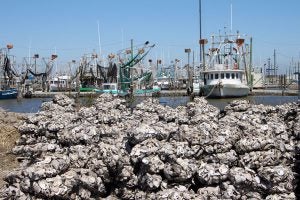The Bivalve that Could Help Save the Coast
Oysters are a part of our culture
Oysters are a Louisiana cornerstone—they’re tasty, they’re beautiful, they bring people together and they just might save the coast. The unparalleled Louisiana oyster is equally at home in the bourgeoisie fine dining establishments and the laissez-faire po’ boy shop, and they have landed in some of the region’s signature dishes: oysters Rockefeller, oyster dressing and seafood gumbo.

Culinary kudos aside, these intricate invertebrates hide a strikingly beautiful surprise on the inside. Their artistic value isn’t apparent from their unassuming gray and asymmetrical outsides, but pop an oyster open and it reveals a unique off-center deep indigo mark sharply contrasted against a gleaming mother-of-pearl backdrop. Many craft vendors mimic the patterns or show off the natural creations by transforming them into spoon rests, ornaments and wall-hangings, all paying homage to one of Louisiana’s favorite creatures. As for their ability to bring folks together, well, a sack of oysters simply can’t be tackled solo! In ode to the oyster, there are now annual oyster festivals in New Orleans, Violet and Baton Rouge that congregate enthusiasts, master shuckers and competitive eaters.
But we owe more than cultural praise to the briny bivalves – did you know that these modest mollusks also help to protect our coastline?
The Role of Oysters in Coastal Restoration
Did you know that oysters also make an appearance in Louisiana’s Coastal Master Plan as a restoration tool? Oysters hold a unique distinction: they are both a resource to be restored and a restoration supply. Vast barrier oyster reefs once shielded large swaths of coastal Louisiana from the onslaught of elements coming from the Gulf. Sadly, about 85% of these reefs are now gone—a result of multiple factors including overharvesting, pollution, disease and altered hydrology.
Oysters are a valued resource for our economy, supporting a commercial fishery that produces one third of the nation’s supply and feeding our local seafood markets and restaurants. But the presence of oysters in the water brings an additional set of benefits to the ecosystem: they filter and clarify water, they serve as a food source for fish, crabs, and birds, and when they grow as reefs, their complex structure provides valuable habitat for various creatures of the estuary. When it comes to protecting our coast, these porous, intertidal reefs form a natural infrastructure as good as any coastal engineering design. They dissipate wave energy and, because they are living, can self-repair and grow in three dimensions to keep pace with environmental changes like sea level rise.
These living shorelines exist because oysters are an expansive breed—they tend to settle and grow on top of one another, attached by a cement-like secretion. Baby oysters (larvae) swim freely in the water column where they seek a hard surface to settle. Now, if you’ve spent time in Louisiana’s coastal waters, you know that hard surfaces like rocks are in short supply. Their preferred hard surface is the shells of other oysters—living or dead. That’s where CRCL’s Oyster Shell Recycling Program comes in.
CRCL’s Reefs and Recycling Program

Restaurants in the Greater New Orleans area have the opportunity to give back to the coast by giving back their shells! CRCL currently partners with 19 restaurants to coordinate collection of their discarded oyster shell through a third-party recycler. Restaurants select the volume and frequency of collection that they need, pay a discounted service fee (CRCL subsidizes the full cost with grant funding), and are then featured in our Restaurant Guide, website and promotional events. The restaurants separate shell from the rest of their waste, and we take care of the rest! CRCL ensures that, once collected, all of the shells will be returned to our coastal waters for reef restoration and shoreline protection projects.
So far, we have collected over 4,000 tons of shell–that’s over 8 million pounds! Over 1,000 volunteers have rolled up their sleeves to help shovel, bag and move shell to prepare for reef projects. We’ve already deployed two reefs, creating over 3,000 linear feet of living shoreline that is now helping to buffer our coastal marshes from erosion. We’re thrilled to see new oysters growing on our reefs already and we’re carefully monitoring their performance over time to extract lessons that we can apply to new projects.
There are so many ways to get involved and show your commitment to the coast: patronize our partner restaurants, encourage other restaurants to join, sign up to volunteer, or become a member of CRCL today.
Above all, remember that the coast is our culture, and our culture is the coast—we can’t have one without the other, and giving back can be delicious. So, “Once you shuck ‘em, don’t just chuck ‘em!”
